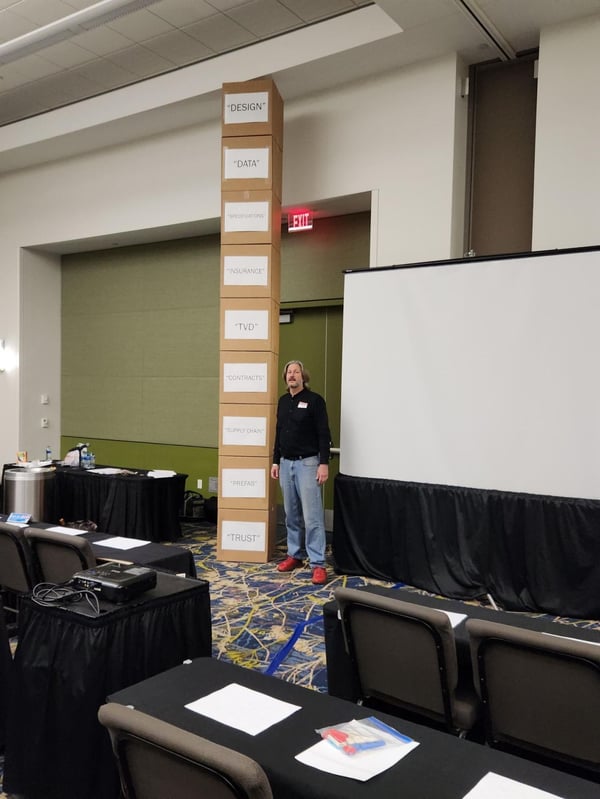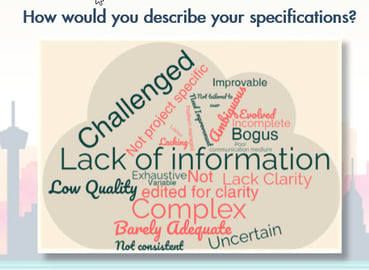
On the field, on the pitch, on the court or on the ice.…take your pick….the players rely on one another to execute plays and create a successful outcome – to win the game. Without strategic contributions, correctly timed, by the correct position, the outcome may result in an error or fumble. Setbacks can happen in reaching the goal, which we can describe as VE (value engineering) in the AEC industry, resulting in cost and scope cutting. Because specifications play such a critical role in every project, having a team mentality in the approach to this documentation is essential for the development.
In baseball: the Pitcher is the Architect, the Catcher is the Specifier and the Estimator (yes, they are one position to provide the most value to the team), the Owner is the Umpire. The Architect pitches the idea, the Specifier/Estimator receives the idea and can frame the pitch to help the Umpire make a call. The Owner (Umpire) decides whether the pitch was good (strike) or bad (ball).
Conspectus is passionate about this concept, particularly pairing the specifier and estimator. We spent the past few months presenting at and attending contractor conferences investigating the validity of this idea. What we found is that not only is it correct, it is necessary to reduce and eliminate waste, RFIs, VE, and even risk on projects.
Let’s look at a breakdown of key points that build strong specs through the contributions of the team, and will win the game, and how each point was validated in our travels.
- Collaboration: Specifications are not the responsibility of a single individual but a team effort. Different stakeholders, such as project managers, engineers, designers, and clients, need to work together to define the project requirements and objectives of the Owner. Each team member brings expertise and perspective to ensure a comprehensive and well-rounded specification.
**VALIDATION: Master Builders, Iowa - Dave Stutzman & Steve Gantner presented with Charlie Dunn of DPR. "Measure Twice, Cut Once. Enhanced Planning and Documenting Strategies". Trust is the cornerstone of everything, from team member interaction, to integrity of documentation. The depth and breadth of benefits that collaboration provides is tremendous. We will revisit this MBI presentation in a future blog.

- Early Involvement: It is important to involve the entire project team from the beginning stages of the specification development. By including all relevant parties early on, you can tap into their knowledge and insights, address potential conflicts or challenges, and ensure a shared understanding of the project's goals.
**VALIDATION: Advancing Preconstruction Conference, Phoenix (May, 2023) Dave Stutzman attended this conference, and the common theme that wove through presentations and conversations, was the importance of who is brought to the table, and when. Estimators and specifiers are the power pair that help in prioritizing tasks, allocating resources effectively, and continuously informing decisions about project scope, schedules, and budgets.
- Decision Making: Specifications serve as a foundation by recording decisions made throughout the project lifecycle. They provide a clear framework for evaluating design choices, selecting technologies and materials, and making informed decisions that align with the project's objectives. By basing decisions on the agreed-upon specifications, the team can maintain consistency and avoid diverging from the Owners Project Requirements.
**VALIDATION: CURT (Construction Users Roundtable) Annual Conference, San Antonio (Feb. 2023) Dave Stutzman, Steve Gantner, and Michael Dubreil of PTAG, presented the results from our contractor roundtable. The team dug into how documenting processes provide guidance to decision making. The SPD (System Performance Descriptions), similar to UNIFORMAT®, is a checklist that ensures nothing is missed. It is based on the theory of 'say what you know, when you know it', it is formatted for the estimator to efficiently price.


- Timing: The timing of decision-making is crucial to the success of a project. Delays or rushed decisions can lead to rework, increased costs, missed deadlines and added cost. Specifications should be established and refined in a timely manner to ensure that the decision-making process remains on track. Regular checkpoints and reviews can help maintain momentum and allow for adjustments as needed.
**VALIDATION: COAA (Construction Owners Assoc. of America) Spring Conference, Charlotte (May, 2023), attended by Dave Stutzman. There is a continuous and ongoing conversation with owners in how they are able to review documents throughout the process. Without proper timing of specs, the owner's ability to review and validate decisions is limited. What if the contractor put a veil on the construction site, and removed it for the owner to review for a few minutes, and threw it back on? Very unrealistic. Yet, often times that is how specifications are presented to Owners, if at all.
- Decision Management: Specifications and estimating go hand in hand in the decision management process. Estimating involves assessing the resources, time, and costs required to fulfill the specifications. It helps in making informed decisions about project feasibility, resource allocation, and budgeting. Accurate estimation relies on well-defined specifications, and the two processes work together to support making effective decisions throughout the entire project.
**VALIDATION: AGCMO Annual Conference, Steve Gantner was on a panel discussion presentation with a general contractor, mechanical contractor, and safety contractor. The focus of the conversation was on RFIs surrounding safety issues. Can decision management, through proper documentation reduce this risk? 100%.
%20(2)-Mar-31-2023-10-33-16-9596-PM.png?width=600&height=600&name=Social%20Media%20-%20conspectus%20(LinkedIn%20Post)%20(2)-Mar-31-2023-10-33-16-9596-PM.png)
In summary, specifications are indeed a team sport, requiring collaboration, early involvement, and a well-managed decision-making process. By following these principles, the project team can establish clear goals, and make informed choices, resulting in better project outcomes. Conspectus enjoys learning from and working with all of the team players, to create a successful project, and win the game!
